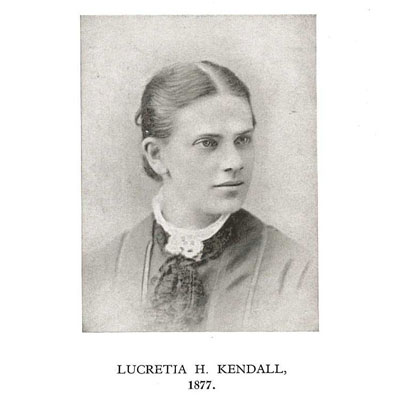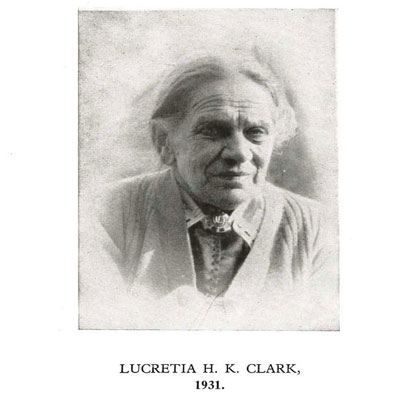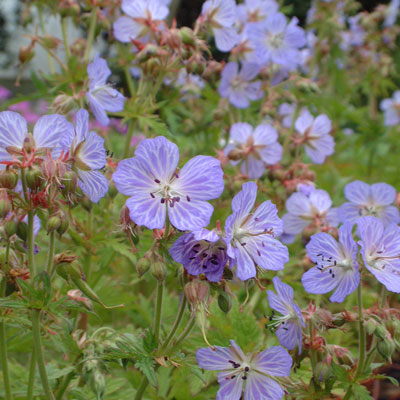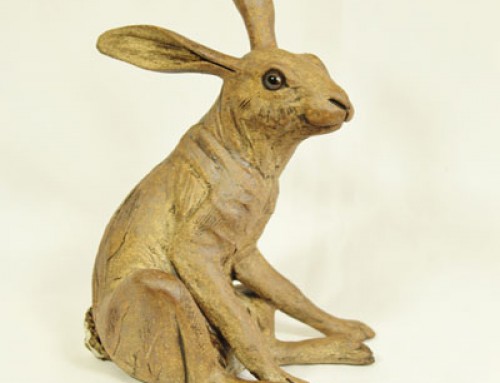Lucretia Hasseltine Kendall Clark (1853-1937)


photos by courtesy of the Alfred Gillett Trust
Lucretia Hasseltine Kendall (1853-1937)
Most references record that the identity of the woman honoured by the cranesbill, Geranium pratense ‘Mrs Kendall Clark’ is lost to history. The story is given that the nurseryman Walter Ingwersen received a Geranium from a customer in the 1930’s which he subsequently named in her honour, beginning to sell it from 1938 onwards.
Following a clue that the customer may have had a connection to the Clark’s shoes family Jennifer Harmer has managed to compile enough evidence to be reasonably sure that Lucretia was that customer. She lived at the right time quite close to the Ingwersen Nursery and both she and her husband had a keen interest in Natural History. It is not an unreasonable assumption that this interest lead them to chance upon a new form of our native cranesbill, which grows abundantly around their district, and as recorded customers of the Ingwersen Nursery could have sent it to him to propagate.
Lucretia was born in Maine, USA, the daughter of Reuben Safford Kendall, (1814-1873), and Lucretia Hasseltine Kendall (born Kimball), (October 16 1821 – ?). She was one of 3 sisters. In her younger days, before retiring to get married, her mother was an instructor at the Presbyterian-affiliated Jacksonville Female Academy in Jacksonville, Illinois, which she headed in the years 1849-1851. She was greatly loved by her pupils and the college is said to have thrived under her charge.
Lucretia married James Edmund Clark (1850-1944) in Boston, USA, in 1879, having met while both studying Natural Science at the University of Heidleberg.
James Clark was educated at Bootham School and Flouders College, and took a BA at University College London. He then became a science schoolmaster at Bootham School, York for many years (where his brother in law Fielden Thorp was headmaster) until his early retirement in 1897 due to hearing problems. During his time at Bootham he studied natural science at the University of Heidelberg where he met his wife to be. He was a founding editor of the Natural History Journal and a Fellow of the Geological Society of London. His scientific interests centred on glacial geology, meteorology and phenology. On his retirement he applied unsuccessfully for the post of headmaster of Leighton Park and instead became a partner as a Colonial and Eastern exporter in London. The couple retired from Purley to Street in 1929 and resided at Burleigh Redroofs, Portway
During her time at York, Lucretia was recorded as having spoken entertainingly to a suffrage meeting at the Town Hall, though her position in the movement was not recorded.
Lucretia became an Honorary member of Bootham School Natural History Society.
(research by Jennifer Harmer)
Geranium pratense ‘Mrs Kendall Clarke’
Each individual flower is like a church window, beautiful powder blue with pale translucent veins. In Geranium pratense ‘Mrs Kendall Clarke’ the flowers are held well above the foliage on stiff upright stems and face boldly outwards. 2ft. June-July. Equally at home in the border or wild garden. Will rebloom if cut back after flowering. The original plant is described as being pearl-grey with a rosy tint, but over the years it has changed and the form now found in the trade is the powder blue, veined form that we sell.



















































